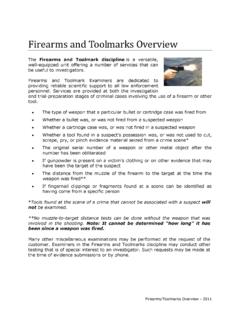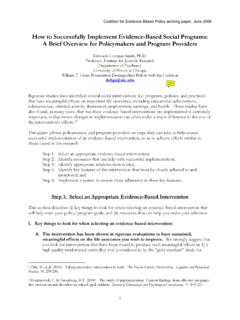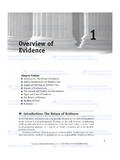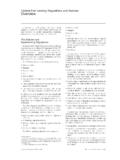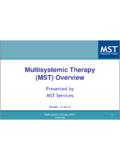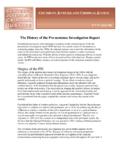Transcription of Latent Prints Overview - Georgia
1 Latent print Overview - 2011 Latent Prints Overview Latent Prints are impressions produced by the ridged skin, known as friction ridges, on human fingers, palms, and soles of the feet. Examiners analyze and compare Latent Prints to known Prints of individuals in an effort to make identifications or exclusions. The uniqueness, permanence, and arrangement of the friction ridges allow examiners to positively match two Prints and to determine whether two friction ridge impressions originated from one source. Latent Prints are among the most valuable and common types of physical evidence . All objects at the scene of the crime should be considered as possible sources of fingerprints that may lead to identification of the offender. By examining the evidence submitted, the laboratory may be able to: Determine the presence of Latent Prints Determine if the Latent Prints are identifiable Compare and identify Latent Prints with the inked Prints of suspects and with others for elimination purposes Establish the identity of unknown deceased persons Identify the print via the Automated Fingerprint Identification System (AFIS) A variety of techniques, including use of chemicals, powders, lasers, alternate light sources, and other physical means, are employed in the detection and development of Latent Prints .
2 In instances where a Latent print has limited quality and quantity of detail, personnel may perform microscopic examinations in order to make conclusive comparisons. Louis Kriel, Impressions Manager, 404-270-8181 Services and Prioritization The Latent print Section accepts evidence from all case types but limits cases involving Latent Prints on suspected drugs and/or paraphernalia from possession cases due to volume. These cases are accepted only after consultation with law enforcement and prosecution officials. If it is decided that the LP section will accept this type of evidence , the content needs to be removed prior to submission of the evidence to LP section Cases are prioritized based on the type of incident. Crimes against persons involving injury or death take precedence over property crimes when the incoming cases are assigned.
3 This is a general rule and exceptions are made on a case by case basis. Latent print Overview - 2011 The section processes evidence and compares question friction ridge impressions to submitted known samples, the GBI AFIS database, and the FBI IAFIS database, as warranted. Latent print (LP) Processing evidence Types In fingerprint comparisons the continuity of the ridge flow is vital to the outcome of the comparisons. Smoother surfaces usually deliver better quality impressions, but depending on the specific surface, it is possible to obtain fingerprints from rough or textured surfaces. It is therefore recommended that investigators contact the section for guidance when in doubt about the suitability of items for submission. evidence types are categorized based on the porosity of the surfaces.
4 Surfaces are generally divided into three types: Porous Surfaces These types of surfaces absorb water and water soluble deposits in the sweat very quickly after deposition. Examples: Paper, checks, currency, tissue, cigarette butts, cardboard, fabrics, untreated wood, etc. Probability of getting usable Prints : High. Best methods for developing Prints : A series of processes in the following order - Visual examination, DFO (1,8-Diazafluoren-9-one), Ninhydrin (1,2,3-triketohydrindine hydrate), Physical Developer (Silver Physical developer). Non-Porous Surfaces These types of surfaces do not absorb the sweat. The fingerprint deposits can remain on the surface for a very long time. Examples: Latent print Overview - 2011 Glass, certain type plastics, polythene bags, metal surfaces, glazed ceramics, glossy paints, etc.
5 Probability of getting usable Prints : High. Best methods for developing Prints : A series of processes in the following order - Visual examination, Superglue (Cyanoacrylate Ester), Fluorescent Dye Stain (for example, Rhodamine 6G), various types and colors of fingerprint powders that are mainly used when the impressions are difficult to photograph due to location on the evidence . Semi-Porous Surfaces - These types of surfaces absorb water and water soluble deposits in the sweat slowly after deposition. Examples: Certain type plastics, waxed surfaces, certain types of wall paints, papers with a glossy finish, varnished wood, etc. Probability of getting usable Prints : High. Best methods for developing Prints will depend on the specific level of porosity.
6 Either one of the two processes or a combination of the two processes described above can be followed. Special Surfaces Wet surfaces - Surfaces that have been wetted before being submitted for processing ( , items left out in the rain, firearms discarded in lakes, etc.) generally require special handling by the section. Processes do exist to recover fingerprints on wet or previously wetted items. Probability of getting usable Prints : Medium to Low. Best methods for developing Prints : o Porous substrates tend to give better results with Physical Developer. o Non-porous substrates are usually treated with powder in suspension ( , Small Particle Reagent or Wet Powder). Surfaces contaminated with blood Fingerprints made in blood or with blood require special treatment.
7 Fingerprints can be left by hands contaminated with blood even after the blood has dried on the hands. Some blood specific reagents will produce positive results with areas that came in contact with the dried blood. When fingerprints are left on surfaces covered with blood, they are usually visible before processing and need to be photographed with special lighting techniques before any further processing. Probability of getting usable Prints : High. Latent print Overview - 2011 Best methods for developing Prints : Blood sensitive reagents can usually be applied after the normal processing. o Porous substrates - both DFO and Ninhydrin will react with blood since both are protein stains. Amido Black can be used to enhance contrast.
8 O Non-porous substrates - DFO can be applied on dark colored substrates and Amido Black on light colored substrates after normal processing. Surfaces contaminated with grease or oil Because ordinary processes are inhibited by the grease or oil, these surfaces require special treatment. Examples: Disposable fast food containers and utensils Probability of getting usable Prints : Medium on Non-porous and Low on Porous. Best methods for developing Prints : Gentian Violet or Sudan Black. Surfaces with adhesive sides Examples: Various tapes including electrical tape and duct tape, labels, envelopes and stamps. Probability of getting usable Prints : High. Best methods for developing Prints : Powder in suspension techniques such as Wet Powder after the non-adhesive side has been processed with normal processes.
9 Thermal paper These papers usually turn black with ordinary porous processing techniques and need special treatment. Examples: Cash register receipts and fax paper. Probability of getting usable Prints : High. Best methods for developing Prints : Special application methods of DFO and Ninhydrin. Firearms Firearms usually require a very thorough visual examination as the substrates are often oily. Depending on the specific circumstances of the case, in some instances firearms may need to be dismantled and all individual parts processed. Probability of getting usable Prints : Due to the variation in manufacturing protocol can range from High on some firearms to Low on others. Best methods for developing Prints : Due to the substrate usually being metal and oily, the visual examination is vitally important.
10 The usual non-porous process is followed on all parts that are not porous. Often the stock is untreated wood that needs to be treated with the porous process. Latent print Overview - 2011 Cartridges and cartridge casings Brass items need special treatment. Fingerprints have been successfully recovered from spent cartridge casings even after being exposed to the high heat from the explosion. Probability of getting usable Prints : Medium to Low depending on the metal used for manufacturing as well as the state of corrosion of the evidence . Best methods for developing Prints : Usual non-porous procedure with the addition of Gun Blue (Selenium Dioxide) as a last step. Latex gloves Gloves can be successfully processed as semi-porous surfaces. They should be submitted as soon as possible in order to obtain positive processing results.
